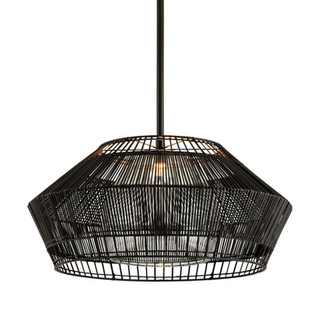Rattan, Malacca, and Buri Ting Ting
- Hudson Valley Lighting
- Apr 29, 2020
- 3 min read
Natural Materials in Troy's New Line

Have you happened to notice that rattan is having a bit of a moment?
Perhaps it was inevitable. With the bohemian vibes creepin' up like, well, like rattan vines to make spaces as relaxing as they are cool (we all just needed to chill a bit this year, didn't we?), this ubiquitous '70s staple could not be far off. Kind of in the same wheelhouse as wicker and bamboo, rattan has several layers and parts which are transformed through ancient crafting techniques into home decor magic. While malacca, rattan, and buri ting ting all refer to the resilient and versatile tropical palm and the many products artisans and craftsmen make from it, wicker can be made out of bamboo or straw, though it is sometimes crafted of rattan.
It's this material, rattan, that is cropping up in novel ways as well as traditional ones in many spaces and the work of world-class designers.

Two things that set any interior space apart are a layered use of contrasting textures and inclusion of the natural world.
Rattan brings nature and texture into the interior space at once, and makes for an accent both casual and alluring. It's got a sense of worldliness and that authenticity that only comes with things that are made by hand. It's easy, approachable, and yet also beautiful and entrancing.
Each person's mileage for it will vary. Some can't get enough of it and want every piece of furniture to feature woven cane of some kind. Others' threshold is at one or two accents, tops.
Mark D. Sikes, who recently introduced a collection for Hudson Valley Lighting called CLASSICS, loves the material, and used it in his Curves No. 1 fixtures.
Troy Lighting's most recent line of releases also features the material.
Left to Right they are Balboa, Breuer and Hunters Point. All showcase the timeless material, giving it the Troy treatment.The design of each features intriguing uses of layering, dimension, and contrast. While all three feature rattan, the end result looks quite different in each.
Breuer's large shade is made of malacca, which is the stem portion of the rattan plant. Often used for walking sticks and umbrella handles, this part of the plant also has a history of association with command. Breuer's shape and size strike a commanding presence in any space it illuminates.
Rattan takes on a different aspect in Hunters Point. This version of the versatile material is called buri ting-ting. It's made by stripping the fronds into long, thin pieces. Here, artisans have then soaked these strips in our espresso-colored dye and hand-wrapped them around the metal frame forming the fixture's outermost layer. Its contrasting shapes, its angles and curves, its dark colors and natural textures all make Hunters Point a striking and dynamic piece sure to infuse a space with energy and interest.
Balboa sets malacca stem sections of rattan into a wave pattern, bound together by thinner strips of rattan where one wave's apex meets the ending of one and the beginning of another above it. Set at a distance from an inner column of fabric shade that softly diffuses the light, this outer frame has a relaxing vibe due to both its natural material and the universality of its wave pattern.

Not made of rattan, Conga's macramé pattern of twisted Havana rope similarly infuses a space with texture and a sense of the natural world met with the craftiness of the human hand. Also layered over a fabric shade and set into the shape of the drum which gives it its name, the resulting frame has a universal quality, giving rhythm to the light.















































